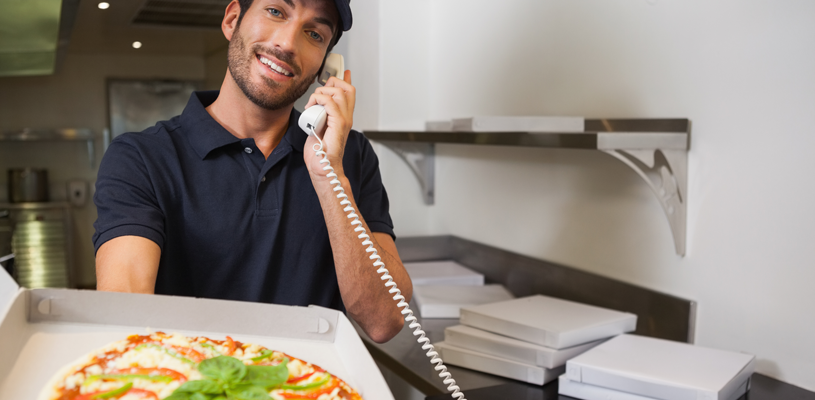Lessons from pizza delivery

When was the last time your pizza was delivered late? If you’re like me, it’s been a while. I’ve ordered pizza in Canada since I was a teenager, and I’ve never had a pizza delivered late. Maybe I’ve just been lucky?
I’m hardly a “lucky” person. During that same time, my luggage has gone “astray” several dozen (possibly more than 100) times, furniture and appliances are regularly delivered hours outside of the “delivery window” (if at all), flights were delayed, canceled, or overbooked, plumbers and other contractors never perform as expected – and the list (mine and yours, I suspect) goes on and on.
So, until corrected, I’ll assume that our experiences in this area are suspiciously similar. Are we merely the cherished and favoured children of the Pepperoni Pizza Gods? Or, is there something else at work to separate the level of customer service provided by pizza companies from that provided by nearly every other service provider? I suspect there are two major factors at play.
Most pizza companies offer an “X minutes or free” delivery policy (and I don’t order from those who don’t). It creates a powerful incentive to get the pizza to your door on time. The “or free” part is important. It’s not a promise of, “X minutes or you get a 10 percent discount off your next pizza,” but a simpler, clearer promise: If we don’t do as we say, it’s 100 percent free.
Can you imagine the increase in on-time deliveries for new furnaces if, when not delivered as promised, they were free?
The next factor is that we have direct access to the person ultimately responsible for the level of customer service: the store manager. We can, if we choose, walk in and have a one-on-one discussion with the person in charge.
Try doing that if you’re overbooked on your next flight. There is no way to speak with the single person responsible. The organization is too large. The decision makers are deliberately, safely hidden behind a thousand layers of bureaucracy.
Customer service is an important aspect of every role in every organization. Our initial impression of an organization is determined by how well we are served; it is shaped by our first encounter with any of its many employees. Perhaps it’s unfair, but our perception of how much the entire organization cares is based upon our encounters – with nurses, parking attendants, receptionists, help line workers …
Customer service is an issue worthy of our focus and attention. Sadly, however, based on daily experience, it’s treated more as a dusty branch of alchemy. Interesting, perhaps, to others – but not ourselves.
The unfortunate reality is that there’s no short, concise bullet point list of “do’s and don’ts” that an organization can follow to immediately increase the number of smiles on the faces of departing customers. But, we can begin thinking about the barriers to good customer service by asking a simple question:
When interacting with a customer/client/constituent, does every employee act as if they are the only employee in a one-person company?
That’s a fairly simple concept: “I am the organization!” And, it’s a concept that has prerequisites and consequences.
The prerequisite is related to power/authority. Am I really the organization? Can I make decisions? If I can’t (or rather, if I’m not allowed to) make decisions, then I’m not the organization.
If I’m not the organization, then I have lower motivation to make sure that customer service is always first rate.
(Of course, being allowed to make decisions within clearly defined boundaries is necessary – and even appreciated by most people.)
This prerequisite is enough to make good customer service, in most organizations, no more than a pipe dream.
Consider the inevitable consequence of having a single receptionist responsible for greeting people and connecting them with their meetings and being responsible for answering all incoming calls.
It’s not just that both tasks are impossible to schedule. It’s that there’s an inescapable conflict in that person’s responsibilities. He or she must both answer phone calls immediately and pay full attention to the person on the other side of the counter. That’s not possible in this universe.
Nor do they have the ability/power/authority to decide to let the phone ring, and instead pay attention to the person in from of them. So much for “customer service.”
The consequence is simpler to summarize. It’s the realization that, if I am indeed the only person in the organization, and the customer isn’t satisfied, I’ll soon be out of work.
That’s the motivation behind the “X minutes or free” policy – it’s clear to everyone (from the customer, to order taker, to pizza maker, to boxer, to delivery person) that delivering free pizzas isn’t a sustainable business model. Everyone realizes that customer service is important and does everything in their power to deliver a hot pizza on time.
That simplicity of purpose is unknown in larger organizations where complicated processes offer more opportunity for things to go wrong. Making sure receipt of my parking ticket payment is processed before sending out the county sheriff to confiscate my first born male child as partial payment (Only for example of course – that hasn’t happened yet) is admittedly more difficult than delivering a pepperoni pizza on time.
But, the lack of simplicity doesn’t mean that we should ignore customer service. Think of it this way: mistreat people the way you’d like to be mistreated. MW
Peter de Jager believes that customer service is the art of standing on both sides of the counter.
as published in Municipal World, June 2016



